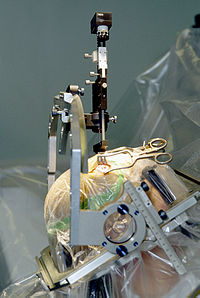
Photo from wikipedia
In the 18th century, anatomy was the principal science underlying surgical practice. Over the next three centuries, the scientific basis of surgery changed dramatically. Morbid anatomy led to the understanding… Click to show full abstract
In the 18th century, anatomy was the principal science underlying surgical practice. Over the next three centuries, the scientific basis of surgery changed dramatically. Morbid anatomy led to the understanding of organ-based pathologies that allowed surgeons to remove, reconstruct and in some cases replace internal organs. In the 19th century, the new science of microbiology facilitated antisepsis, then asepsis as surgery progressed from a craft to a scientific discipline. Yet many surgeons believed that surgery was not merely a science but also an art, in which the creativity of the doctor was necessary for progress. Surgical advancement depended on creative individuals with innovative flair, prepared to pioneer often risky procedures in the face of mainstream opposition. The 20th century saw a series of changes that made such individualism more difficult. ‘Scientific Management’ when applied to surgery decreed that procedures be performed according to predetermined schedules, a drive to uniformity producing better outcomes and diminishing individual variation. Yet inventive individuals continued to produce surgical advances. In the 21st century, moves toward standardisation developed further. The escalating safety culture in surgery moderates the introduction of novel, potentially riskier procedures, while more and more regulation increasingly requires surgeons to adhere to guidelines and protocols, further restricting surgical individualism. Moreover, the role of the individual is further diminished, as surgical care is delivered by teams, both in deciding management in major cases and in the operating theatre. The introduction of robotics into surgery has led to the suggestion that the role of the surgeon may become that of a technician. Will these constraints, and greater patient involvement in decisions, allow tomorrow’s surgeons the freedom to innovate? We believe that the pioneering spirit, imagination and flair will not be lost. Tomorrow’s surgeons must remain doctors, showing the compassion and empathy that robots cannot provide.
Journal Title: Journal of the Royal Society of Medicine
Year Published: 2022
Link to full text (if available)
Share on Social Media: Sign Up to like & get
recommendations!